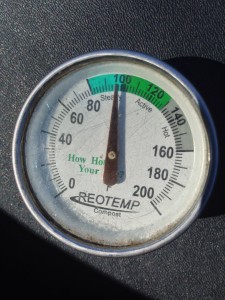
Started in the coldest weather, it took three weeks for this pile to heat up.
This has been a very cold, very snowy (snowiest on record, more falling as I type this, on March 28, 2015) winter. Even in these toughest conditions you can successfully start a compost and get it cooking.
I took this photo March 23, about one month after starting a new compost pile. Despite outdoor temperatures reaching above freezing only a few times, the pile was up over 100°. A week later the compost temperatures have been hovering between 110-120°.
How did I do this? The most important part was probably having a compost bin available to use.* I added as usual: 1 part food scraps, 2 parts carbon (shredded leaves, many left in the bin), as fast as I could. I also added two big bags of used coffee grounds (high in nitrogen) from Starbucks.
As I’ve said before, we have a lot of food scraps because we do a lot of vegetarian cooking – that helps. Sometimes neighbors, community organizations or others can help by providing their vegetarian food scraps. Getting a critical mass of food in the unit quickly helps it heat up. However, if you add material slowly, it only means that your compost will be slower to heat, which isn’t a problem.

This photo was taken March 12, 2015. These are the tops of a low tunnel poking through the snow. They weren’t visible for months.
Given the snow still on the ground and the predicted 3″ more today, I’m not sure when I’ll get to do anything in the garden. This compost pile probably won’t be ready until May, at the earliest. At that point it will be great for topping off some potato containers, mulching the vegetable gardens or to spread on the lawn.
So don’t let cold weather dissuade you from starting a compost. You can do it even in record-breaking winters!
*This bin had been full of shredded leaves. A few weeks prior, I emptied most of the leaves so I could start this pile.
